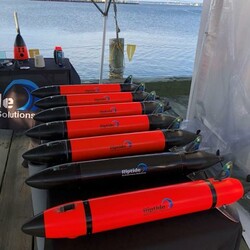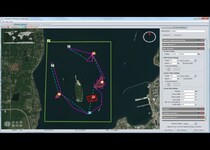Swarms of Underwater Drones Deliver the Goods in Naval Exercise
CAMBRIDGE, MA—To prepare for the rapidly arriving future environment that will include increasing numbers of autonomous undersea vehicles, the U.S. Navy has selected 23 companies to participate in a five-year, potential $794.5 million contract to support the research-and-development of unmanned undersea vehicles. Under the contract, Draper will provide the Navy with materials and services for the development, manufacturing and fabrication of undersea vehicles.
Unmanned systems are a growing area of importance for the Navy as the service requested an additional $1 billion in fiscal year 2019 funding to nearly $3.7 billion, according to the Association for Unmanned Vehicle Systems International. That would be the largest year-over-year increase in unmanned systems funding for all the main service branches, AUVSI said.
“Autonomous undersea vehicles are growing in importance for commercial and national security purposes. Draper’s heritage in proven military systems and technologies provides the Navy with flexibility—in mission design, operation and resource deployment,” said Joel Parry, Draper’s maritime warfare and intelligence, surveillance and reconnaissance (ISR) lead.
Recently, Draper joined Riptide Autonomous Solutions and Teledyne Benthos in a demonstration during the Advanced Naval Technology Exercises (ANTX) at the Naval Undersea Warfare Center, Newport, Rhode Island. In the demonstration, five unmanned undersea vehicles completed a simulated offensive mission in the open sea. The sortie involved the vehicles transiting 2 miles while maintaining undersea communications, surfacing for periodic GPS fixes, going into a loiter, acoustically passing targeting coordinates, receiving instructions to engage and then closing in on a simulated surface target.
Riptide provided the vehicle components of the swarm with its micro-UUVs. Teledyne Benthos provided a custom configuration of their Band C Compact Acoustic Modem, and Draper provided the mission level autonomy through its Maritime Open Architecture Autonomy (MOAA) platform, now available as a no-cost option on all government procured Riptide UUVs. Draper developed MOAA for the U.S. government as a government-controlled, configuration-managed, extensible open architecture for mission autonomy designed to bring greater flexibility in mission design, operation and resource deployment on any UUV.
“Staying ahead of an adaptable adversary requires a flexible, multidisciplinary system development approach,” said Bill Borgia, mission systems director at Draper. “UUVs support myriad Navy missions by combining affordability, endurance and strength through scale.”
Draper has six decades of experience in unmanned and robotic systems for air, land and sea. From the depths of the ocean to the moon and beyond, Draper’s unmanned systems help our military, civil and commercial customers accomplish their most difficult challenges.
Released September 13, 2018




